|
|
 |
|
Cyclopoida ( Order ) |
|
|
|
Oncaeidae ( Family ) |
|
|
|
Triconia ( Genus ) |
|
|
| |
Triconia pacifica Cho, Kim, Böttger-Schnack, Lee, 2013 (F,M) | |
| | | | | | | Ref.: | | | Cho & al., 2013 (p.1, Descr.F, M, figs.F,M, Rem.) | 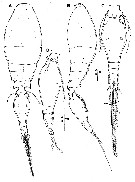 Issued from : K. Cho, W.-S. Kim, R. Böttger-Schnack & W. Lee in J. Nat. Hist., 2013. [p.5, Fig.2]. Female (10°30'N, 131°20'W): A, habitus (dorsal); B, habitus (lateral); C, urosome (dorsal), setae on caudal rami are numbered using Roman numerals; D, urosome (lateral). Scale bars in µm. Exosqueleton well chitinized, surface covered with numerous small pits (similar to the skin of an orange). Prosome 1.7 times length of urosome excluding caudal rami, about 1.5 times urosome length including caudal rami. P2-bearing somite without conspicuous dorso-posterior projection in lateral aspect. Pleural areas of P4-bearing somite with postero-lateral corners elongated and pointed. Urosome 5-segmented, comprising P5-bearing somite, genital double-somite, and 3 free abdominal (postgenital) somites. P5-bearing somite with pair of mid-dorsal secretory pores. Genital double-somite 1.8 times as long as maximum width at anterior half (measured in dorsal aspect) and 1.9 timesas long as postgenital somites combined, flask-like shape. Paired genital apertures located at about half distance from dorsal anterior margin ; armed woth 1 spine and 2 minute spinous processes (arrowed in figure 13B). Surface with paired secretory pores at ¼ distance from posterior margin. Anal somite about as wide as long ; slightly longer than caudal rami. Caudal ramus about 1.6 times as long as wide, inner margin unornamented ; with 6 setae (numbered using Roman numerals in fig. 2C). Seta I and II spiniform, unipinnate along medial margin, others setiform and plumose. P5 with small free exopodal segment and very long plumose outer basal (= protopodal) seta, more than 3 times longer than outer exopodal seta and extending as far as 4/5 from anterior margin of genital double-somite, reaching beyond genital apertures as far as paired pores on dorsal surface (fig.2D, seta probably not shown in full length in fig.13A). Exopod a little longer than wide, with 2 setae, which are spiniform and unornamented, the outer one slightly longer than the inner one. P6 represented by operculum closing off each genital aperture; armed which 1 long spine and 2 minute blunt processes (arrowed in fig.13B).
|
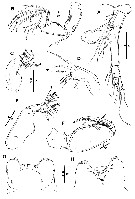 Issued from : K. Cho, W.-S. Kim, R. Böttger-Schnack & W. Lee in J. Nat. Hist., 2013. [p.7, Fig.3]. Female: A, A1; B, A2 (anterior), distazl elements on distal endopod segment numbered using capital letters, lateral elements indicated by Roman numerals; C, Md, individual elements indicated by capital letters; D, Mx1 (arrow indicating ornamentation of element next to outermost element; E, Mx2; F, Mxp (anterior); G, labrum (anterior); H, labrum (posterior). Scale bars in µm. Nota : A1 6-segmented ; armature formula : 1-3, 2-8, 3-5, 4- 3+ae, 5-2+ae, 6-6+1+ae. A2 3-segmented; relative lengths (%) of segments approx. 39 : 33 : 28. Coxobasis with row of long, fine spinules along outer and inner margins and with few additional denticles on proximal and distal part of router margin. Proximal endopod segment subtriangular forming outer lobate outgrowth bearing patch of spinules and single row of denticles along inner posterior margin. Distal endopod segment with 2 rows of short spinules along outer margin of posterior surface and additional row of minute spinules at distal part of anterior surface. Lateral armature consisting of 1 spiniform seta (III), pectinate at distal half, and 3 naked setae (seta I shortest) ; distal armature consisting of 5 curved setae (A-E) and 2 slender naked setae (F-G) ; setae A-D unipinnate, setae A-C similar in length, seta D slightly shorter ; seta E longest and naked ; seta G shorter than seta F, both seta shorter than seta D. Labrum distinctly bilobed, with 6 to 7 large dentiform processes of graduated length medially on distal margin of each lobe and row of minute spinules along outer margins. Posterior wall of medial concavity with 4 strong dentiform processes (‘’teeth’’) and paired sclerotized indented elements either side of teeth (Fig.3H) ; posterior surface with group of 3 secretory pores on proximal part of each lobe. Md without surface ornamentation ; gbathobase with 5 elements (numbered using capital letters) ; element A at subdistal ventral corner about as long as ventral blade B, with long, fine setules along dorsal margin, tip of element not reaching as far as tip of blade B ; ventral blade B strong and broad, with row of setules on posterior surface ; dorsal blade C with dentiform processes along entire dorsal and distal margins ; dorsal element D setiform and bipinnate, shorter than multipinnate element E. Mx1 weakly bilobed, surface ornamented with few spinules. Inner lobe with 3 elements: innermost one pinnate, located at some distance from others, middle element naked, about same length as outermost element, which is strong and spiniform, fringed with few strong spinules at midregion and spinulose at distal part. Outer lobe with 4 elements: 2 outer elements setiform and bipinnate, outermost element longest, element next to innermost spiniform and strong, with double row of short spinules, similar in length to innermost element, which is setiform and naked. Mx2 2-segmented, comprising syncoxa and allobasis. Syncoxa unarmed, surface ornamented with few curved spinular rows and 1 large secretory pore; allobasis produced distally into slightly curved spinous process (claw) bearing 2 rows of strong spinules along inner (= medial) margin; stout seta on outer margin reaching as far as tip of allobasal claw, ornamented with few spinules distally (arrowed in fig.3E); medial margin with slender spinulose seta and strong spinous seta ornamented with 2 large spinular rows along medial margin and few spinules at outer (= lateral) margin. Mxp 4-segmented. Syncoxa unarmed, posterior surface ornamented with 2 short rows of spinules. Basis robust, with 2 spiniform spinulose elements on inner (= palmal) margin, distal element stronger and 1.4 times longer than proximal one; fringe of long pinnules between distal seta and articulation with endopod, row of spinules between proximal and distal seta and short transverse row on anterior surface (fig.3F); other ornamentation on outer margin of anterior surface absent or not discernable. Proximal endopodal segment unarmed. Distal endopodal segment (claw) with row of fine pinnules along proximal 3/4 of concave margin; with minute naked seta on outer proximal margin and unipectinate spine fused basally to inner proximal corner of claw.
|
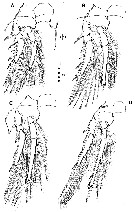 Issued from : K. Cho, W.-S. Kim, R. Böttger-Schnack & W. Lee in J. Nat. Hist., 2013. [p.8, Fig.4]. Female: A, P1 to P4 (anterior views). Scale bars in µm; (a showing basal seta of P1). Scale bars in µm.
|
 Issued from : K. Cho, W.-S. Kim, R. Böttger-Schnack & W. Lee in J. Nat. Hist., 2013. [p.13]. Female: Swimming leg armature formula P1 to P4.
|
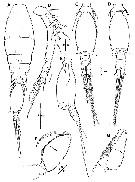 Issued from : K. Cho, W.-S. Kim, R. Böttger-Schnack & W. Lee in J. Nat. Hist., 2013. [p.9, Fig.5]. Male (NE equatorial Pacific): A, habitus (dorsal); B, A1; C, urosome (dorsal); D, urosome (ventral); E, urosome (lateral); F, Mxp (anterior); G, Mxp (mdial view), syncoxa not fully shown. Scale bars in µm. Nota : Urosome 6-segmented, comprising P5-bearing somite, genital somite and 4 free abdominal somites. Genital somite about twice as long as postgenital somites combined. Genital somite with 5 secretory pores on dorsal surface. Surface ornamentation on genital flaps and on ventral surface of anal segment as indicated in fig. 5D. Caudal rami with length to width ratio about 2 : 1, larger than in female. A1 4-segmented, distal segment corresponding to fused segments 4-6 of female. Mxp 3-segmented, comprising syncoxa, basis and one-segmented endopod. Syncoxa unarmed, ornamented with single secretory pore at inner distal margin and few spinules on surface. Basis robust and expanded, armed with 2 small naked setae of equal length within longitudinal cleft ; anterior surface with 1 to 3 transverse spinular rows and row of short flat spinules along inner margin (fig.5G), without expanded flap ; posterior margin with 2 to 3 longitudinal rows of spatulated setules of graduaded length (fig. 5G). P5 exopod fused to somite, slightly shorter than in female, armature as in female ; outer basal seta about 2.7 times as long as outer exopodal seta, relatively shorter in female. P6 represented by posterolateral flap closing off genital aperture on either side ; surface ornamentation as indicated (fig. 5D). Posterolateral corners protruding laterally, clearly visible in dorsal aspect.
|
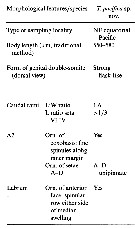 Issued from : K. Cho, W.-S. Kim, R. Böttger-Schnack & W. Lee in J. Nat. Hist., 2013. [p.16, Table 2]. Morphological characters of Triconia pacifica of the Triconia dentipes-subgroup from the north-eastern equatorial Pacific. Nota: Orn: ornamentation; L: length; W: width; Compare with related species and form variants of the Triconia dentipes-subgroup from the north-eastern equatorial Pacific and from other regions: T. dentipes, T. elongata, T. giesbrechti (Pacific form), T. giesbrechti (Red Sea form), T. constricta.
|
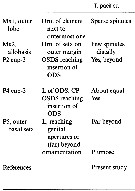 Issued from : K. Cho, W.-S. Kim, R. Böttger-Schnack & W. Lee in J. Nat. Hist., 2013. [p.17, Table 2 (Continued)]. Morphological characters of Triconia pacifica of the Triconia dentipes-subgroup from the north-eastern equatorial Pacific. Nota: Orn: ornamentation; OSDS: outer subdistal spine; ODS: outer distal spine; CP: distal conical process. L: length; W: width. Compare with related species and form variants of the Triconia dentipes-subgroup from the north-eastern equatorial Pacific and from other regions: T. dentipes, T. elongata, Red Sea) T. giesbrechti (Pacific form), T. giesbrechti (Red Sea form), T. constricta.
|
 Issued from : K. Cho, W.-S. Kim, R. Böttger-Schnack & W. Lee in J. Nat. Hist., 2013. [p.29, Fig.13]. Female: A, P5 and genital double-somite (dorsal); B, genital aperture, arrows indicating minute spinous processes close to spine.
| | | | | NZ: | 2 | | |
|
Distribution map of Triconia pacifica by geographical zones
|
| | | | | | | Loc: | | | NE equatorial Pacific, Korea Strait
Type locality: 10°30'N, 131°20'W. | | | | N: | 1 | | | | Lg.: | | | (1166) F: 0,553-0,582; M: 0,472; {F: 0,553-0,582; M: 0,472} | | | | Rem.: | For Cho & al. (2013, p.14) the species is closely related to T. dentipes with a striking similarity to its sibling in general habitus and in the form of the female genital double-somite. | | | Last update : 02/02/2015 | |
|
|
 Any use of this site for a publication will be mentioned with the following reference : Any use of this site for a publication will be mentioned with the following reference :
Razouls C., Desreumaux N., Kouwenberg J. and de Bovée F., 2005-2025. - Biodiversity of Marine Planktonic Copepods (morphology, geographical distribution and biological data). Sorbonne University, CNRS. Available at http://copepodes.obs-banyuls.fr/en [Accessed January 05, 2026] © copyright 2005-2025 Sorbonne University, CNRS
|
|
 |
 |










